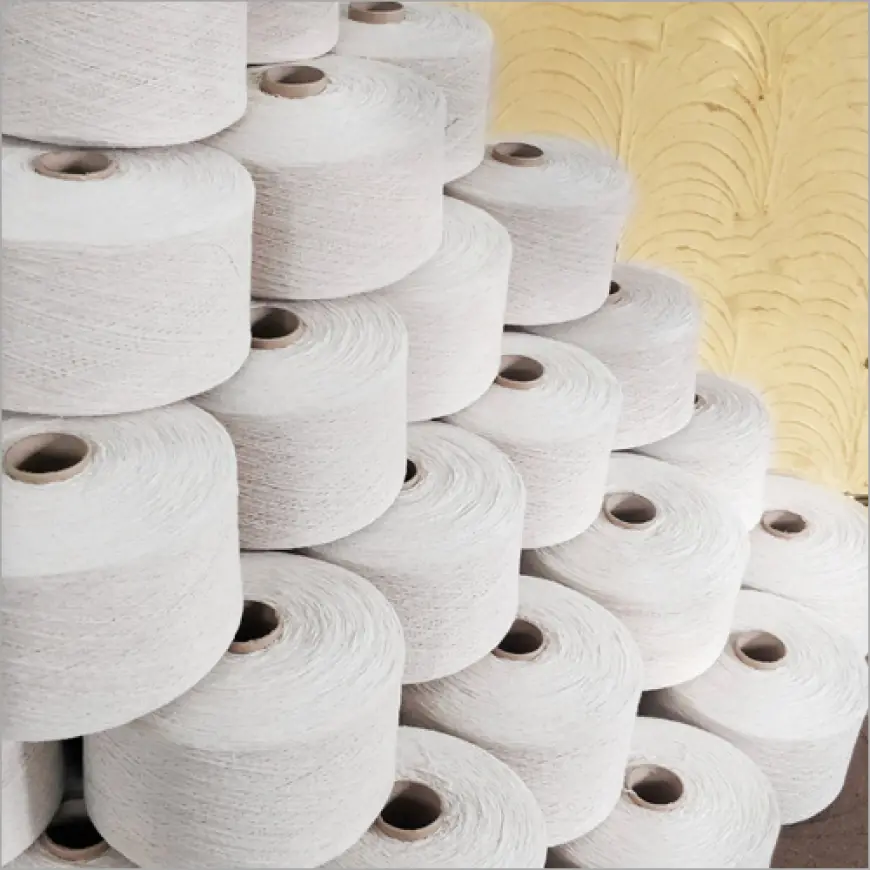How AI is Revolutionizing the Recycled Yarn Industry in 2025
Discover how AI is revolutionizing recycled yarn production in 2025. Learn how manufacturers and suppliers are using AI to scale sustainably and improve quality.

In 2025, sustainability is not just a trend—it’s a business imperative. As global industries shift towards greener solutions, the textile industry is experiencing a significant transformation. At the heart of this change lies Recycled Yarn—a sustainable solution made from post-consumer or post-industrial textile waste.
But while recycled yarn has been around for years, what’s truly changing the game now is Artificial Intelligence (AI). From sorting textile waste to improving fiber quality and production efficiency, AI is playing a vital role in helping Recycled Yarn Manufacturers and Suppliers scale sustainably.
Let’s explore how AI is revolutionizing the recycled yarn industry in 2025.
? 1. Smart Waste Sorting with AI Vision Systems
One of the biggest challenges in the recycled yarn production process has always been waste segregation. Traditional methods relied heavily on manual sorting, which was time-consuming and error-prone.
Now, thanks to AI-powered vision systems, machines can:
-
Identify and separate cotton, polyester, nylon, and blended fabrics using image recognition and sensor data
-
Detect contaminants, stains, or synthetic materials that can't be processed
-
Sort large volumes of textile waste 10x faster than manual labor
This technology is helping Recycled Yarn Manufacturers improve raw material quality, reduce wastage, and optimize costs.
⚙️ 2. Predictive Maintenance for Yarn Production Machines
Production downtime can significantly hamper the efficiency of Recycled Yarn Suppliers. AI-enabled predictive maintenance tools monitor machinery in real-time and:
-
Detect anomalies in spinning, carding, or blending machines
-
Predict failures before they happen
-
Recommend proactive maintenance schedules
This not only saves money but also ensures continuous production without compromising on the quality of recycled yarn.
? 3. AI-Powered Quality Control Systems
In 2025, customers are demanding both sustainability and quality. Recycled yarn must meet performance benchmarks similar to virgin yarns. AI helps here too.
Smart quality control systems equipped with machine learning models can:
-
Analyze yarn strength, thickness, and twist levels in real time
-
Monitor for defects such as knots, unevenness, or contamination
-
Automatically reject sub-standard yarn during production
For Recycled Yarn Suppliers, this means reduced returns and enhanced customer satisfaction.
? 4. Demand Forecasting and Inventory Optimization
Supply chain disruptions are common in the textile world. With AI-driven demand forecasting tools, Recycled Yarn Manufacturers can now:
-
Predict order trends based on historical sales, market data, and seasonality
-
Plan raw material procurement more efficiently
-
Avoid overproduction or stockouts
This reduces both material waste and operational costs while ensuring consistent availability for buyers.
? 5. Fiber Blending Optimization Using AI
Creating the perfect yarn blend—especially when mixing recycled and virgin fibers—requires deep technical expertise. Today, AI models trained on thousands of blend recipes can:
-
Suggest ideal proportions for desired softness, durability, or elasticity
-
Adjust settings in real time based on material quality
-
Maintain consistent output across large batches
This helps Recycled Yarn Suppliers produce high-quality, customized yarn for fashion, home textiles, and industrial applications.
? 6. Personalized Yarn Solutions with AI-Powered Customization
AI is also enabling personalization at scale. Leading recycled yarn manufacturers now use AI to offer tailored solutions to their clients:
-
Small-batch, customized yarn orders for niche fashion labels
-
Yarn coloring and texturing based on trend analysis from social media
-
Real-time order tracking and quality reports for every batch
This level of customization builds stronger relationships between suppliers and brands looking for unique, eco-conscious textile solutions.
? 7. Real-Time Sustainability Monitoring and Reporting
Transparency is a major focus in 2025. Brands want to know how sustainable their materials truly are.
AI helps Recycled Yarn Manufacturers:
-
Track carbon emissions, water usage, and energy consumption during production
-
Generate automated ESG reports for compliance and brand credibility
-
Offer traceability through blockchain + AI systems, ensuring that yarn is truly recycled and ethically made
This aligns perfectly with global sustainability goals and gives buyers peace of mind.
? 8. Smart Factory Automation in Recycled Yarn Units
AI doesn’t just live in software. In 2025, smart factories are integrating AI with IoT sensors and robotics to automate:
-
Bale opening and fiber cleaning
-
Spinning and twisting processes
-
Packaging, labeling, and warehouse management
These AI-driven operations result in higher productivity, fewer human errors, and scalable production—especially for Recycled Yarn Manufacturers exporting globally.
? 9. Empowering Small-Scale Manufacturers with AI Tools
AI isn’t just for large corporations. Open-source AI platforms and affordable cloud solutions are helping small recycled yarn producers:
-
Access insights from global market trends
-
Train their workers with AI-assisted learning modules
-
Compete effectively in both domestic and international markets
This democratization of AI is building a more inclusive and resilient textile ecosystem.
? Conclusion: AI + Recycled Yarn = A Greener Future
As the world moves toward circular fashion and climate-responsible manufacturing, the synergy between Artificial Intelligence and Recycled Yarn is unlocking game-changing potential.
From smarter production to predictive analytics, AI empowers Recycled Yarn Manufacturers and Suppliers to meet growing demand, cut waste, and maintain top-notch quality—all while protecting the planet.
In 2025, it’s clear: the future of textiles is not only green—it’s also intelligent.
What's Your Reaction?
 Like
0
Like
0
 Dislike
0
Dislike
0
 Love
0
Love
0
 Funny
0
Funny
0
 Angry
0
Angry
0
 Sad
0
Sad
0
 Wow
0
Wow
0




















































